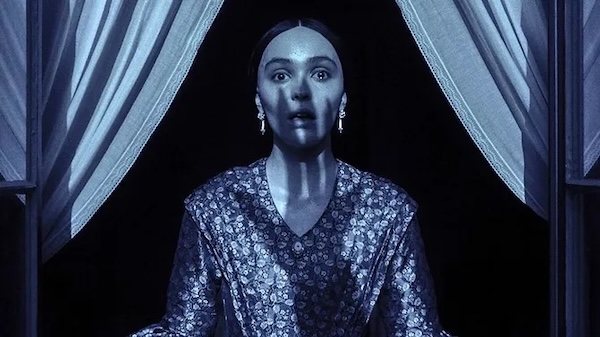Film Review: “Nosferatu” — Stay for a Bite
By Nicole Veneto
Director Robert Eggers’s take on the venerable vampire is a little too buttoned-up, too clean, too refined.
Nosferatu, directed by Robert Eggers. Playing in cinemas around New England.

Lily-Rose Depp succumbs to the darkness in Nosferatu. Photo: Focus Features
How do you remake a famous film?
Some films are so timeless that their legacy seems to preclude a remake entirely (e.g., The Wizard of Oz, a remake of which is in development by nobody remotely qualified). Sometimes a new approach teases out thematic elements that take the source material in interesting directions. There’s also the matter of execution, the success of which relies on the strength of the director, their vision, and their ability to translate it to the screen. It’s dependent as well on where filmmaking is at the moment: the technology at hand and the cultural-political atmosphere invoked. Remaking films is not unlike adapting Shakespeare — it’s the same story, just told and framed differently. For these and other reasons, some of the most effective remakes have been horror films. Hell, a couple of the best horror films ever made are remakes, like The Thing and The Fly.
F.W. Murnau’s Nosferatu is an interesting case. Nosferatu is Germany’s unauthorized version of Bram Stoker’s Dracula, the finest example of eluding copyright if there ever was one. Although Murnau and Max Schreck’s Count Orlok created a definitive silent classic, Werner Herzog took a swing nearly 60 years later with an actual crazy person, Klaus Kinski, and the effort was truly stunning. So how does Robert Eggers’s new adaptation a century after Murnau’s fare? Nosferatu is the director’s dream project, the film he’s worked his entire career toward. Unfortunately, Eggers’s Nosferatu is one of those highly anticipated movies I went into expecting to love and left merely liking. Despite some bold technical and thematic choices, Nosferatu is his weakest film to date: it never quite emerges from the shadows cast by Murnau’s “original” or Herzog’s take.
The plot of Eggers’s Nosferatu is the plot of Herzog’s Nosferatu, which is the plot of Murnau’s Nosferatu (itself essentially Stoker’s novel with some tweaks to skirt copyright law). Newlywed Thomas Hutter (Nicholas Hoult) is sent away to Transylvania to sell a home to Count Orlok (Bill Skarsgård), a centuries-old vampire who traps him before embarking on a ship bound to Wisborg. Back at home, Hutter’s wife Ellen (Lily-Rose Depp, taking over for Anya Taylor-Joy) is plagued by sleepwalking spells and an overwhelming dread that her husband is in danger. When Orlok arrives in Wisborg, he unleashes a deadly plague on the town. Ellen realizes the only way to end the plague is to sacrifice herself to Orlok, distracting him from sensing the first rays of dawn, which will (and do) destroy him. The end.
The primary (and most interesting) detour Eggers makes from earlier versions is that Ellen has encountered Orlok before. Nosferatu opens on a sobbing young Ellen praying for an angel of comfort. What she summons instead is Orlok, who ravages her in an estate garden to a convulsive orgasm. It’s a darker spin on the reincarnated romance Francis Ford Coppola added to his otherwise faithful 1992 adaptation of Stoker’s novel, a psychic connection between vampire and victim that goes beyond Isabelle Adjani’s premonition of evil in 1979. Though the role was clearly written for Taylor-Joy, Depp meets its demands with a hysterical fervor I didn’t know she was capable of. (For those keeping track, this is the second film in 2024 inspired by Adjani’s performance in Possession).
And of course, there’s Skarsgård’s Orlok. The actor has clearly found a niche in horror films that require him to wear heavy prosthetics; playing Orlok is only fitting to the point of typecasting. Like Nic Cage’s Longlegs, teasing Skarsgård’s transformation provided the bulk of Nosferatu’s marketing campaign. Even the movie milks the anticipation for all its worth, not presenting Orlok in his full corpse-like glory until about 40 minutes in. But how Skarsgård takes to the character in appearance and demeanor isn’t what I fixated on. What’s more pertinent is what Orlok means in Eggers’s film.
Antisemitic allusions aside, Murnau’s Orlok is presented as the ultimate Other. Schrek’s performance is so inhuman that Eggers’s Van Helsing (Willem Dafoe, perfect, no notes) played the actor as an actual bloodsucker in Shadow of the Vampire. In Herzog’s remake, Orlok becomes a tragic figure doomed to a loveless eternity as well as the representative of a pestilence that upends bourgeois social order (or, depending on interpretation, a haunting specter of fascism in postwar Germany). So what does Count Orlok represent in Eggers’s iteration? Ellen outright tells you: he is her shame, the baseline from which all female sexuality is formed. Her love for Thomas is pure, acceptable by 19th-century mores that designated women as their husband’s legal property. Orlok is an unwanted force against that sexual repression, a violent assault on Ellen’s chastity that erupts in uncontrollable bodily fits.
But is this enough to make the film stand on its own? Make no mistake, Eggers’s Nosferatu is assured filmmaking from a director confident in his vision. Jarin Blaschke’s cinematography is appropriately shrouded in darkness (even if a couple shots are a bit too dark to see), the camera gliding through 60-odd sets impeccably designed by Craig Lathrop. Linda Muir’s costuming represents some of her best work, though you’d be forgiven if the flowery bonnets, puffy sleeves, and top hats remind you of The Muppets Christmas Carol. Eggers has never been one to skimp on craft, and Nosferatu provides an appropriate sandbox for his sensibilities.
And yet the end result is rather safe and risk-averse compared to its predecessors. Eggers’s take is a little too buttoned-up, too clean, too refined. The menacing ambience and jarring eccentricities proffered by the 1922 and 1979 versions are what make those films so frightening. Though bound to the technical limitations of silent filmmaking, Murnau’s original employs German Expressionist antirealism to cultivate atmosphere: a shadowy hand seizing a lovely throat (which both Werzog and Eggers pay homage to) and stop-motion photography for Orlok’s otherworldly movements. Along with opening on real mummified corpses, Herzog’s version is accompanied by a constant droning noise that puts you at perpetual unease to the point of nausea.
By contrast, Eggers — a self-described history buff — is a bit too enamored with historical realism. On the one hand, this means wading into archaic (i.e., misogynistic) medical practices used to treat hysteria; Ellen must not only be drugged and restrained at all times, but she must keep her corset on. On the other hand, this commitment to realism is an aesthetic choice that deters Eggers from making his film truly abject. There’s blood, vomit, all kinds of unnatural bodily contortions, and a shit ton of rats. But it’s all there as if by obligation rather than any real desire on Eggers’s part to shock, unnerve, or disgust.
My criticisms notwithstanding, I’m truly happy Eggers got to complete his dream project. Murnau’s Nosferatu is clearly dear to his heart, a source of inspiration since he was nine that led him to making his own horror classics, The Witch and The Lighthouse. This passion translates on screen, and I’d much rather watch a remake made by someone who loves and was inspired by the source material than some director for hire whose only allegiance is to money-hungry producers.
I just wish Eggers put a little more bite into it.
Nicole Veneto graduated from Brandeis University with an MA in Women’s, Gender, and Sexuality Studies, concentrating on feminist media studies. Her writing has been featured in MAI Feminism & Visual Culture, Film Matters Magazine, and Boston University’s Hoochie Reader. She’s the co-host of the podcast Marvelous! Or, the Death of Cinema. You can follow her on Letterboxd and her podcast on Twitter @MarvelousDeath.
.

Just saw this at the Providence IMAX and was quite underwhelmed. You’re better off watching 1979’s Nosferatu the Vampyre directed by Werner Herzog and starring Klaus Kinski, which I saw as a prelude to the current film and feel is far superior. It’s currently streaming on the Kanopy platform. You’re welcome.
Afraid the film is a total disappointment.
Best of all was the 1922 version. This version was plain boring.
There were some disgusting moments but certainly nothing frightening